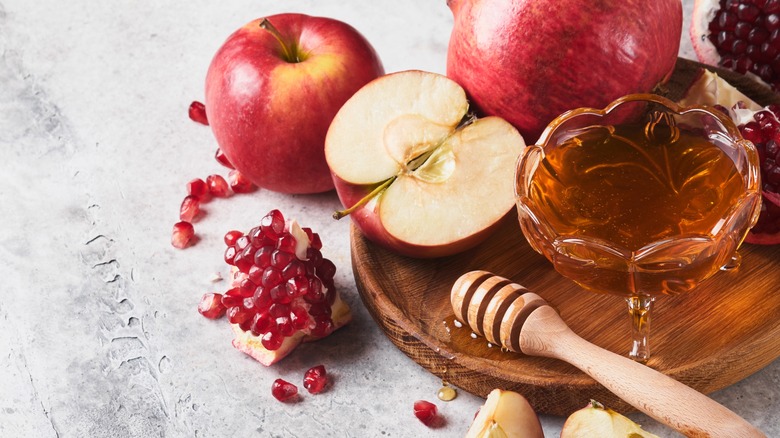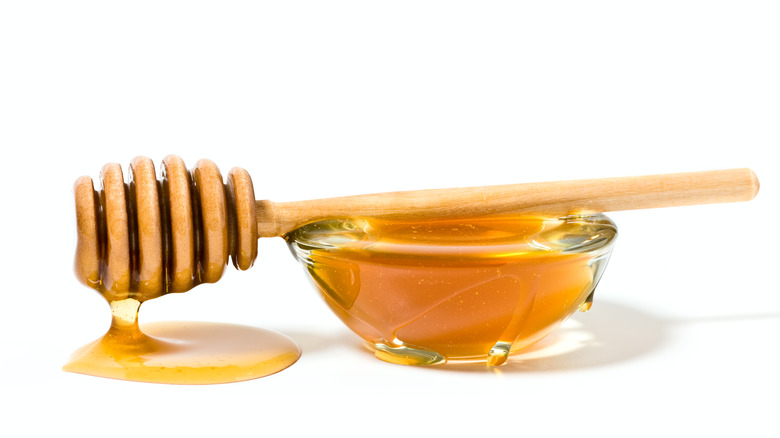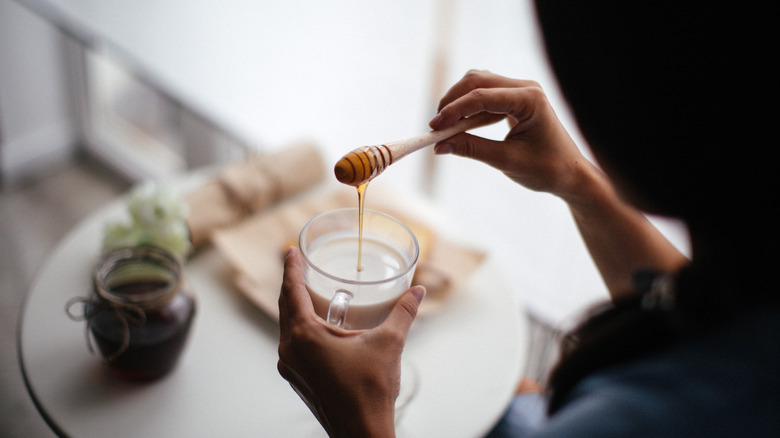Elevate Your Rosh Hashanah Meal By Incorporating Honey In Every Dish
Some of the tastiest ways to celebrate Rosh Hashanah, the Jewish New Year, is to eat the symbolic foods known as Simanim, which symbolize hopes for a good year to come. There are several of these foods outlined in the Talmud, including carrots, beets or spinach, pomegranate, leeks, black eyed peas, gourds, dates, and heads (any kind of head will do, including fish, garlic, and even cabbage). But one of the most important components on any Rosh Hashanah menu is honey, eaten to bring a good and sweet new year (Shana Tova U'Metukah), according to Smithsonian Magazine. Apples are the most traditional accompaniment to honey, but you can incorporate the sweet stuff throughout your entire menu to make the coming year extra sweet.
Grace Singleton, managing partner/in-house artisan food expert at Zingerman's Deli in Ann Arbor, Michigan says that honey can add a lot to all sorts of celebration dishes, and you can easily swap it out for regular sugar.
"Using honey as a sweetener adds an increased complexity and depth of flavor to any classic sweet dish," explains Singleton. "You can replace the sugar in a dish with honey by substituting 1 cup of sugar with two-thirds of a cup of honey and reducing the volume of liquid by a quarter cup."
Honey in dessert
While it's important to have honey on hand for apple dipping on Rosh Hashanah, there are lots of other places where you can add a little sweetness throughout the meal. A natural place is dessert. Singleton suggests using honey to sweeten your own homemade whipped cream, which can give your topping a bit of a toffee-like flavor. She also suggests using honey in a classic noodle kugel, and it would certainly taste great in an apple kugel as well.
If you decide to spring for any special, single variety honeys for dipping, like Tupelo or buckwheat, you can set up a honey flight with bowls of each variety and a supply of apple slices. Single variety honey, sometimes sold as monofloral or unifloral, is made with a single type of flower, so it's nice to taste them side by side to see the differences in color, taste, and aroma. You can also use your specialty honey for drizzling on almost anything for a little pop of flavor.
"For breakfast or dessert, toast up a slice of your favorite bread, add some olive oil, spread some fresh cream cheese or ricotta, and then top it with a drizzle of honey," says Singleton.
Add honey to savory food
Because honey is sweet, it's easy to incorporate in desserts, but there are lots of additional ways to make it work in savory dishes as well. Singleton says to look for any places where you'd traditionally need sugar and simply swap it out. "Include it in a glaze for chicken," she explains, "or in your salad dressing."
You can also get creative and use specialty honey for making a sauce for chicken or fish, or to sweeten up a gravy or pan sauce. Singleton says that darker varieties will, "stand up to more bold flavors and they are often the best ones to use when using honey in a glaze to use on [meat]."
Thin out honey with a little water, mix it with garlic, salt and pepper and use it to coat root vegetables for roasting, or add an egg to that watered-down honey and brush it on top of challah for a shiny, slightly-sweet surface. Make your own honey mustard sauce for dipping or topping chicken by mixing a few simple ingredients you probably already have on hand. Just be sure to get a little extra honey, so you have plenty for dipping and extra for cooking.


